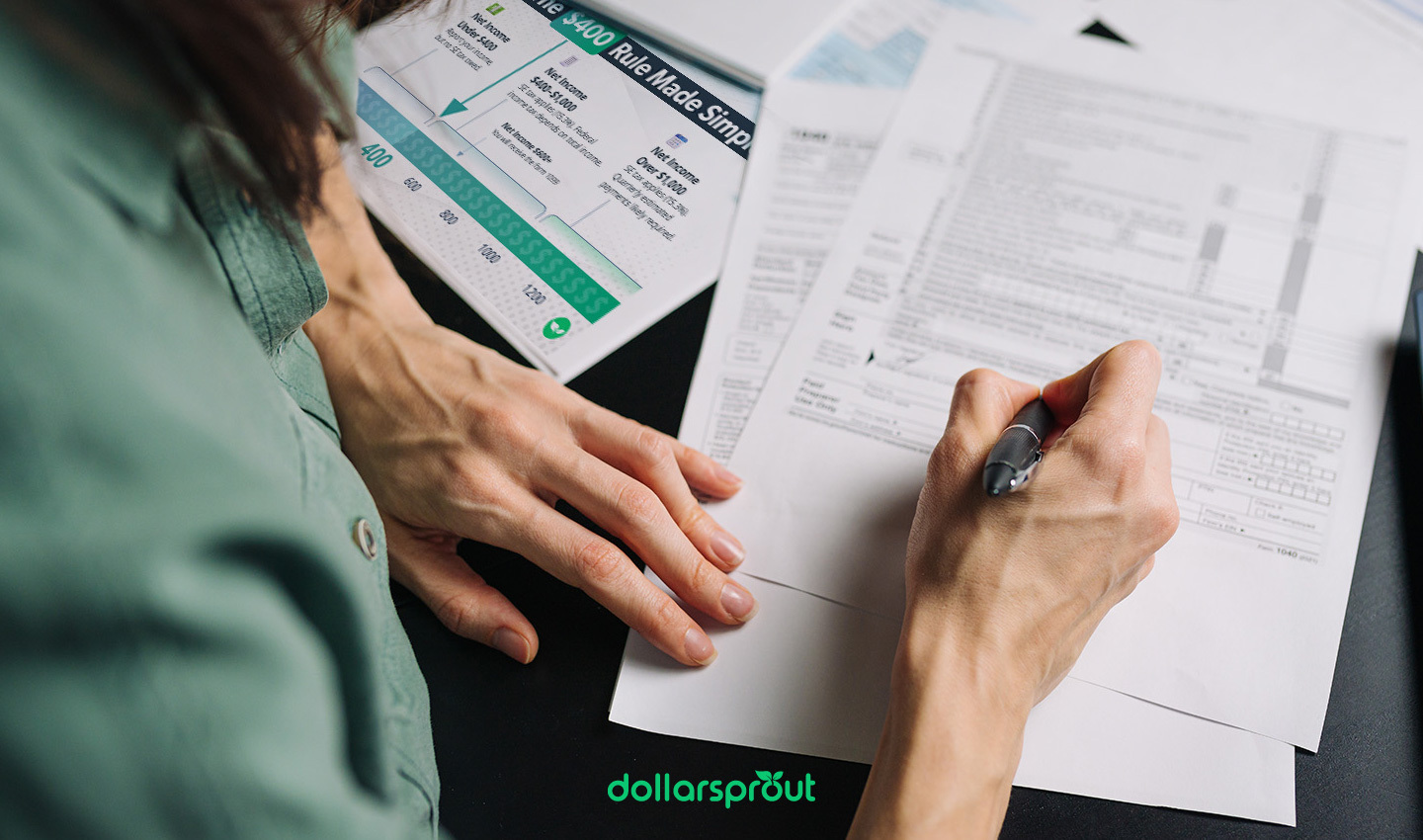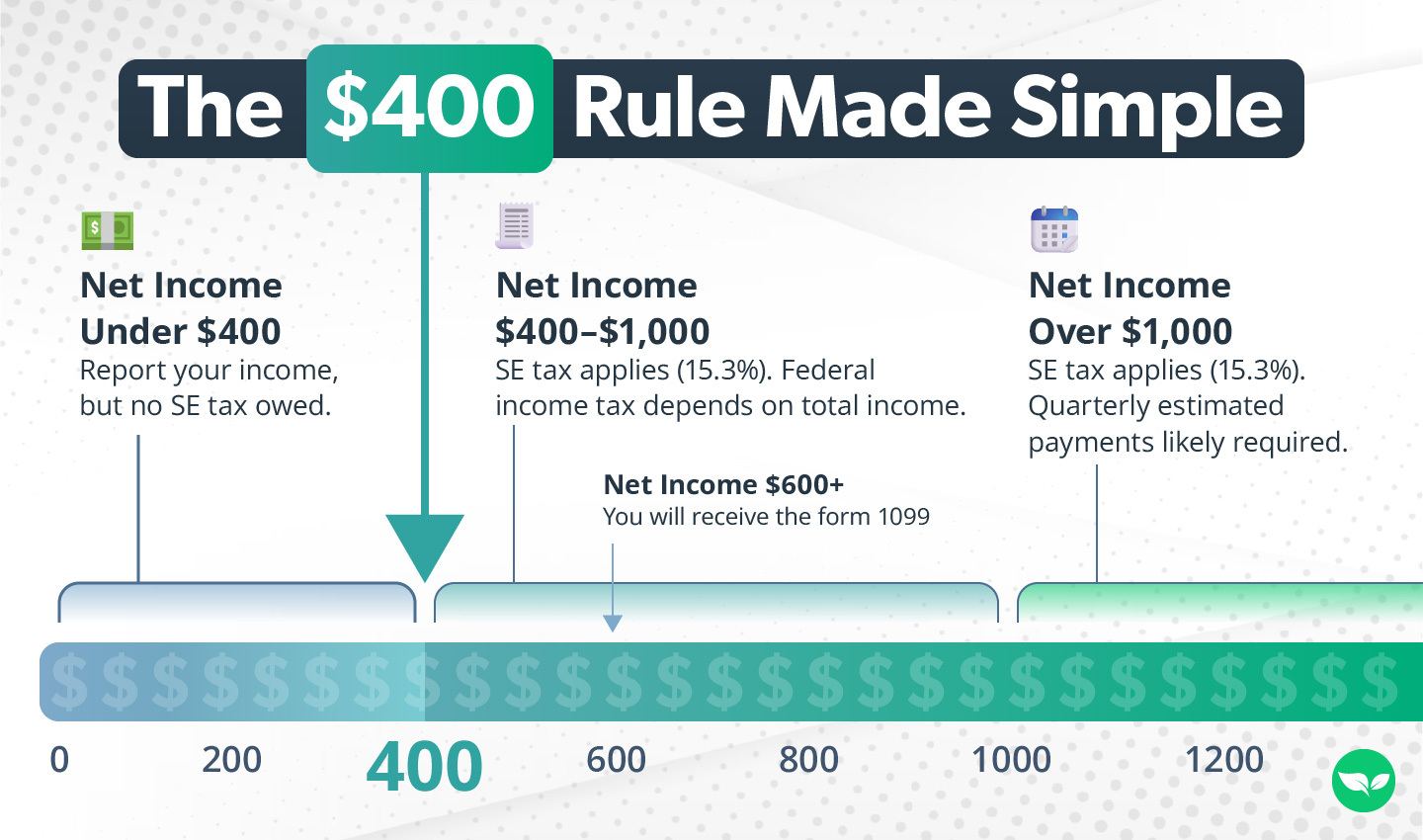The $400 Rule: When Side Hustlers Have to Pay Self-Employment Tax
Think you don’t owe taxes on your side hustle until you hit $600? The real threshold is lower — and it can catch freelancers off guard. Learn how the $400 rule works and what it means for your next tax return.

Many people think that if you earn less than $600 from a side hustle, you don’t owe taxes. Unfortunately, that’s not the case.
That $600 threshold only determines whether a client or platform sends you a 1099 form — it doesn’t determine whether you owe taxes. The truth is that self-employment (SE) tax — the tax that covers Social Security and Medicare when you work for yourself — kicks in once your net profit reaches $400.
In our annual Side Hustle Survey, 68% of side hustlers reported earning less than $500 per month — exactly where this confusion hits hardest.
There’s no need to panic at tax time, though. Let’s break down what this rule really means and what you can do to lower the amount you owe.
What the $400 Rule Actually Means
Once your net side hustle earnings for the year reach $400, you owe self-employment (SE) tax to the government. (Note: that’s net, not gross income.) You’ll pay 15.3% of your earnings for this liability — 12.4% goes to Social Security, and the remaining 2.9% goes toward Medicare.
For example, if you earn $500 as a Lyft driver and deduct $125 in gas costs and car repairs, you won’t owe SE tax because your net income doesn’t exceed the threshold. But if you make $500 from selling artwork on Etsy and only deduct $75 in paint supplies and listing fees, you’ll still have a tax liability.
Keep in mind, this rule only applies to SE tax — not your regular federal income tax. It’s possible to owe nothing in income tax (thanks to deductions and credits) but still owe SE tax if your net profit exceeds $400.
When filing, you’ll report your income and expenses on Schedule C, then calculate any SE tax on Schedule SE. The $400 rule determines whether Schedule SE applies.
For 2025, the standard deduction is $15,000 for single filers and $30,000 for married couples filing jointly. That higher threshold may eliminate your income tax liability — but SE tax is separate.
Related: How This Artist Earns $5K+ a Month Licensing Her Artwork
Why the $600 Myth Trips People Up
The $600 myth persists because many people confuse it with the threshold for 1099-NEC or 1099-MISC reporting. If you earn $600 or more as a contract worker, businesses are required to send you a 1099-NEC showing how much they paid you during the year. This rule has been in place for a long time, but is set to change in 2026.
That said, you won’t always receive one — especially from individuals. For example, if a neighbor pays you $1,000 for dog walking over the course of a year, you technically should get a 1099-NEC, but you probably won’t.
Even without that form, you’re still responsible for reporting your earnings. The IRS expects you to pay taxes on all self-employment income, whether or not you receive a 1099. That’s why it’s so important to track your own income and expenses instead of relying on clients or apps to send year-end forms.
Related: 6 Tips to Avoid an Unexpected Tax Bill from Your Side Hustle
When $400 Isn’t the Whole Story
As a side hustler, you also need to know when to pay taxes. The self-employed have more deadlines to track than traditional W-2 workers.
If you expect to owe more than $1,000 in federal taxes (including self-employment tax) for the year, the IRS requires you to make estimated quarterly tax payments.
For example, if you earn $10,500 from an Upwork side hustle, you’ll owe roughly $1,600 in self-employment tax — more than the $1,000 threshold. That means you’ll need to send portions of that amount to the government four times per year, around the 15th of January, April, June, and September. (Exact dates can shift slightly depending on weekends and holidays.)
Most people use Form 1040-ES to calculate and pay these estimates or offset what’s owed by withholding extra from any W-2 income.
That’s important because ignoring quarterly taxes can lead to penalties.
💡 What Happens if You Ignore Quarterly Taxes?
The IRS doesn’t mess around with missed taxes — but penalties are avoidable.
The IRS can match income through 1099s, bank records, and payment apps like Venmo or Cash App. If you haven’t paid your quarterlies, they’ll add a 0.5% monthly penalty to your balance, plus interest.
For example, if you owed $500 and ignored it for a year, the penalty alone would add about $30 — not counting interest.
Since 27% of gig workers rely on their self-employment income to cover basic needs, it’s important to protect those earnings instead of wasting them on penalties. Even a $400 liability can grow quickly if ignored — but a little planning can prevent that.
How Expenses Can Lower What You Owe
One simple way to shrink your tax bill is to write off the money you spend running your side hustle.
Self-employment tax applies to your net profit, not the full amount you collect. If you keep track of those costs — supplies, fees, mileage, whatever it takes to keep things going — every deduction chips away at what the IRS can tax. In some cases, that can even nudge your income under the $400 mark, meaning you won’t owe self-employment tax at all.
For example, say you earn $450 for the year as a pet groomer. If you deduct $100 in supplies, your net drops below the threshold, so you wouldn’t owe SE tax.
Here’s the kicker: skip the tracking, and you’d owe about $68.85 in self-employment tax you didn’t need to pay.
You can track costs with a simple spreadsheet, but many side hustlers prefer basic accounting tools. Keeper, QuickBooks, FreshBooks, and Wave make it easy to send invoices, categorize expenses, and simplify tax season. For more on recent changes, see which 2025 tax deductions apply to side hustlers.
Related: How to Track Expenses in 3 Simple Steps
The $400 Rule Made Simple
At its core, the $400 rule isn’t complicated. Once your net profit for the year hits that number, you owe self-employment tax — even if you don’t owe regular income tax. Earn more, and quarterly payments might come into play, too.
Here’s a quick way to think about it:
Knowing the rule is one thing. Following it in real life is another. A few simple habits can make the difference:
- Keep tabs on what you earn and spend. Track income and expenses as you go so you’re not scrambling later.
- If you cross the $400 mark, plan for taxes. Set aside about 15% of your profit to cover self-employment tax.
- If you’ll owe more than $1,000, pay quarterly. Sending payments throughout the year helps you avoid penalties — and keeps tax season from sneaking up on you.
It might feel confusing at first, but once you start tracking your earnings, it gets easier. A bit of organization now saves a lot of stress later and helps you stay on top of your side hustle finances with confidence.
Related:
- The Side Hustle You Haven’t Tried Might Be… a W-2 Job
- How to Make $10K a Month: 15 Proven Strategies That Work
- The Freedom Trap: Why Gig Work Isn’t Always Paying Off











